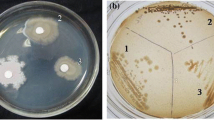Abstract
The effect of six different conjugated bile salts (two trihydroxyconjugated bile salts: tauro and glycocholic acids; and four dihydroxyconjugated bile salts: tauro- and glycochenodeoxycholic, tauro- and glycodeoxycholic acids) on eight bifidobacteria strains were studied. A strong growth-inhibitory effect was observed (80% at 0.95mm) for each bile salt and strain. This phenomenon was explained by the production of deconjugated bile salt during bifidobacteria growth. The deconjugation phenomenon was concurrent with biomass production, and deconjugated bile salts were the sole compound produced during bifidobacteria biotransformation. In resting cell experiments, differences appeared between the strains and the kind of bile salts, particularly concerning taurocholic acid. The Bifidobacterium longum strains were the most efficient among the bacteria tested.
Similar content being viewed by others
Literature Cited
Akiyoshi T, Nakayama F (1990) Bile acid composition in brown pigment stone. Dig Dis Sci 35:27–32
Aries V, Hill MJ (1970a) Degradation of steroids by intestinal bacteria I. Deconjugation of bile salt. Biochim Biophys Acta 202:526–534
Aries V, Hills MJ (1970b) Degradation of steroids by intestinal bacteria II. Enzymes catalysing the oxidoreduction of the 3α, 7α and 12α hydroxyl groups in cholic acid, and the dehydroxylation of the 7 hydroxyl group. Biochim Biophys Acta 202:535–543
Ballongue J (1993) Bifidobacteria and probiotic action. In: Salinen S, Von Wright A (eds) Lactic acid bacteria. New York: Marcel Dekker, Inc., pp 357–427
Ballongue J, Grill JP, Baratte-Euloge P (1993) Action sur la flore intestinale de lait fermentés au Bifidobacterium. Le Lait 73:249–256
Benno Y, Sawada K, Mitsuoka T (1984) The intestinal microflora of infants: composition of faecal flora in breast-fed and bottle fed infants. Microbiol Immun 28:975–986
Blinder HJ, Filburn B, Floch M (1975) Bile acid inhibition of intestinal ananerobic organism. Am J Clin Nutr 28:119–125
Chateau N, Deschamps AM, Hadj Sasi A (1994) Heterogeneity of bile salts resistance in Lactobacillus isolates of a probiotic consortium. Lett Appl Microbiol 18:42–44
Christiaens H, Leer RJ, Powels PH, Verstraete W (1992) Cloning and expression of a conjugated bile acid hydrolase from Lactobacillus plantarum by using a direct plate assay. Appl Env Microbiol 58:3792–3798
Church FC, Porter DH, Catagnagni GL, Swaisgood HE (1985) An O-phtalaldehyde spectrophotometric assay for proteinases. Anal Biochem 146:343–348
Drasar BS, Hill MJ (1974) Human intestinal flora. London, New York, San-Francisco: Academic Press
Fernandes CF, Shahany KM, Amer MA (1987) Therapeutic role of dietary Lactobacilli and lactobacillic fermented dairy products. FEMS Microbiol Rev 46:343–361
Ferrari A, Pacini N, Canzi E (1980) A note on bile acids transformations by strains of Bifidobacterium. J Applied Bacteriol 49:193–197
Floch MH, Gerhengoren W, Diamond S, Hersh T (1970) Cholic acid inhibition of intestinal bacteria. Am J Clin Nutr 23:8–10
Floch MH, Gershengoren W, Elliot S, Spiro N (1971) Bile acid inhibition of the intestinal microflora. A function for simple bile acid? Gastroenterology 61:228–232
Gilliland SE (1989) Acidophilus milk products: a review of potential benefits to consumers. J Dairy Sci 72:2483–2494
Gilliland SE (1990) Health and nutritional benefits from lactic acid bacteria. FEMS Microbiol Rev 87:175–188
Gilliland SE, Speck ML (1977) Deconjugation of bile acids by intestinal lactobacilli. Appl Env Microbiol 33:15–18
Gopal-Srivastava R, Hylemon PB (1988) Purification and characterization of bile salt hydrolase from Clostridium perfringens. J Lipid Res 29:1079–1085
Hughes DB, Hoover DG (1991) Bifidobacteria: their potential for use in American dairy products. Food Technol April: 74–83
Hylemond PB (1985) Metabolism of bile acids in intestinal microflora. In: Danielson H, Sjövall J (eds) Sterols and bile acids. New York: Elsevier Science Publishing Inc, pp 331–343
Ibrahim SA, Bezkorovainy A (1993) Survival of bifidobacteria in the presence of bile salt. J Sci Food Agric 62:351–354
Irvin JL, Johnston CG, Kopalo J (1944) A photometric method for the determination of cholates in bile and blood. J Biol Chem 153:439–457
Khattab AA, Abou-Donia SA (1987) The effect of bile salt on the growth of some lactic acid cultures. Egypt J Dairy Sci 15:51–56
Lundeen SG, Savage DC (1990) Characterization and purification of bile salt hydrolase from Lactobacillus sp strain 100-100. J Bacteriol 172:4171–4177
Lundeen SG, Savage DL (1992) Characterization of an extracellular factor that stimulates bile salt hydrolase activity of Lactobacillus sp strain 100-100. J Bacteriol 172:121–126
Masuda N (1980) Deconjugation of bile salts by Bacteroides and Clostridium. Microbiol Immunol 25:1–11
Midtvedt T, Norman A (1968) Parameters in 7αdehydroxylation of bile acids by anaerobic lactobacilli. Acta Pathol Microbiol Scand 72:313–329
Scardovi V (1986) Bifidobacterium. In: Sneath HA, Mair NS, Sharpe ME, Holt JG (eds) Bergey's manual of systematic bacteriology, Vol 2, 9th ed. Baltimore: Williams and Wilkins, pp 1418–1434
Stellwag EJ, Hylemond PB (1976) Purification and characterization of bile salt hydrolase from Bacteroides fragilis subsp. fragilis. Biochim Biophys Acta 452:165–176
Author information
Authors and Affiliations
Rights and permissions
About this article
Cite this article
Grill, J.P., Manginot-Dürr, C., Schneider, F. et al. Bifidobacteria and probiotic effects: Action of Bifidobacterium species on conjugated bile salts. Current Microbiology 31, 23–27 (1995). https://doi.org/10.1007/BF00294629
Issue Date:
DOI: https://doi.org/10.1007/BF00294629




